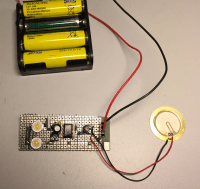Carnival Drum Light

A friend asked me, how he could make a Drum Light for the coming carnival, which would light up, everytime he slams the drum and therefore give some nice Light effect during night performance. First I thought about some microphone followed by some amp and some monostable multivibrator for lighting up some leds.
This project has been published as free Post Project nr. 58. Read it here.
A friend asked me, how he could make a Drum Light for the coming carnival, which would light up, everytime he slams the drum and therefore give some nice Light effect during night performance. First I thought about some microphone followed by some amp and some monostable multivibrator for lighting up some leds. After thinking about this a 2nd time, I rejected this idea, because the microphone might catch too much ambient noise during carnival and could eventually light up just all the time. Therefore another capture device was needed.
Yesterday I stumbled over an old, no more working Alarm clock, where the case was broken, because it obviously crashed to the floor once too much. When I saw the build-in Piezo, I wondered, if this Piezo could not be used as trigger device for this drum story...
So I connected the Piezo to the scope, knocked on the piezo and had already nice big peaks coming from the Piezo. Seemed to work!
So I started the small schematic, which you can find below. Because my friend is not so much used in electronics, I just took the most simple components, which can be obtained very easily, so he should be able to 'clone' the device without problems.
The function is very easy: The Piezo, which will be mounted directly one the drum, is connected via some potentiometer (Sensivity) to an LM555 which is configured as monostable multivibrator. The output pulse of the LM555 can be adjusted by a 2nd potentiometer in the range of around 0 - 1.1sec. At the output there is an output transistor, which drives the Leds. The Leds have been obtained from a dead GU-10 Led-Lamp, where the power-supply has given up, but the LEDs were still working. Naturally you can use any other LED. Don't forget to adapt R5 to your LED type.
For the Power Supply, I used four 1.5V Batteries in series, resulting in 6V. But because the LM555 supports voltages between 4.5 and 16V, any other Battery in this Voltage range might be used. Simply make sure, to adapt the LED resistor R5 according to the used LEDs and the Power Supply, otherwise the LEDs might have a very short life!
Power Consumption:
For Battery operation, the quiescent current of the LM555, which is typically around 3mA, might eventually be quite high. In such situations, it might be a good Idea, to use the LMC555, which seems to have a quiescent current of around 100uA only and a VCC Range of 1.5 - 15V.



Discussion (2 comments)